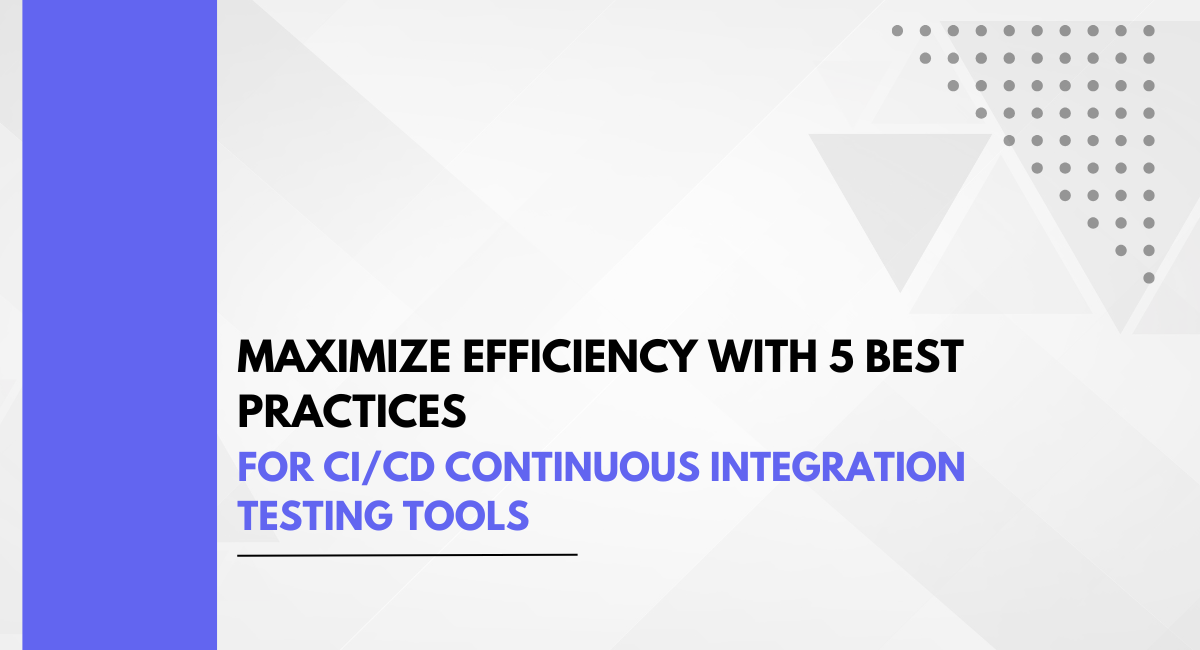Software development teams are under constant pressure to deliver high-quality products quickly and efficiently. The Continuous Integration and Continuous Deployment (CI/CD) pipeline has emerged as a game-changer, streamlining processes and reducing the likelihood of costly errors.
However, maximizing the efficiency of a CI/CD pipeline requires more than just adopting the right tools; it demands a strategic approach that integrates automation, monitoring, and continuous improvement. Read Continuous Integration Testing Tools with 5 best practices.
This article delves into the five best practices that can elevate your CI/CD strategy, ensuring your development pipeline runs like a well-oiled machine. From automating build and deployment processes to leveraging feature flags for controlled rollouts, we'll explore how these strategies can help you catch bugs early, accelerate your time to market, and enhance overall software quality.
1. Automate Your Tests
Automating tests is one of the most critical steps in any CI/CD pipeline. With the help of continuous integration testing tools, developers can write and run tests automatically with each code change. This practice not only saves time but also ensures that bugs are caught early in the development cycle. Tools like Jenkins, GitLab CI/CD, and CircleCI are well-known for their robust automation capabilities, allowing developers to create comprehensive test suites that run seamlessly with each merge request or commit.
According to Simplilearn, "test automation is crucial for CI/CD pipelines as it reduces the manual testing effort and ensures that the application is stable and reliable." By automating tests, developers can focus on writing code rather than manually testing it, thereby increasing productivity and reducing the likelihood of human error.
2. Use Continuous Integration Testing Tools Effectively
Implementing continuous testing tools is just the first step; using them effectively is equally important. Tools such as Selenium for web applications and Pytest for Python projects offer a wide range of features that can help streamline the testing process. The key is to integrate these tools into your CI/CD pipeline in a way that provides immediate feedback on code changes.
This means setting up alerts and notifications so that any issues are addressed promptly, minimizing downtime and ensuring continuous delivery.
3. Implement a Shift-Left Strategy
The shift-left strategy involves moving testing as close to the beginning of the development cycle as possible. This means that developers should write unit tests and integration tests early in the development process rather than waiting until the end. This approach reduces the likelihood of downstream problems and ensures that the codebase remains stable throughout the development cycle.
By leveraging continuous integration testing tools, developers can implement this strategy by creating test-driven development (TDD) workflows where tests are written before the actual code implementation. This not only ensures better code quality but also accelerates the overall development process.
4. Monitor and Optimize Performance
Monitoring performance is essential for any CI/CD pipeline. Continuous integration testing tools provide valuable insights into how the application performs under different conditions. By setting up performance tests and analyzing the results, developers can identify bottlenecks and optimize the application's performance.
For example, tools like JMeter can simulate real-world traffic loads on web applications, while Gatling can provide detailed performance metrics. Integrating these tools into your CI/CD pipeline allows you to run these tests automatically with each build, ensuring that performance issues are caught early and addressed accordingly.
5. Integrate with Version Control Systems
Integrating continuous integration testing tools with version control systems (VCS) is another best practice for maximizing efficiency in CI/CD pipelines. Tools like GitLab CI/CD integrate seamlessly with Git repositories, allowing automatic triggering of jobs upon push events. This integration ensures that every code change is thoroughly tested before it is merged into the main branch. By tying tests directly to commits or pull requests, developers can ensure that their code meets the highest standards of quality before it reaches production.
Maximizing efficiency in CI/CD pipelines with continuous integration testing tools requires a thoughtful and systematic approach. By automating tests, using these tools effectively, implementing a shift-left strategy, monitoring and optimizing performance, and integrating with version control systems, developers can ensure that their software development process is both efficient and reliable.
In today's fast-paced software development environment where continuous integration and delivery are paramount, leveraging these best practices with CI/CD continuous integration testing tools is essential for delivering high-quality software products on time. The future of software development depends on efficient testing methodologies that these tools provide.
You may also be interested in: Effective Test Case Review Process | Best Practices
Book a Demo and experience ContextQA testing tool in action with a complimentary, no-obligation session tailored to your business needs.
We make it easy to get started with ContextQA tool: Start Free Trial.
